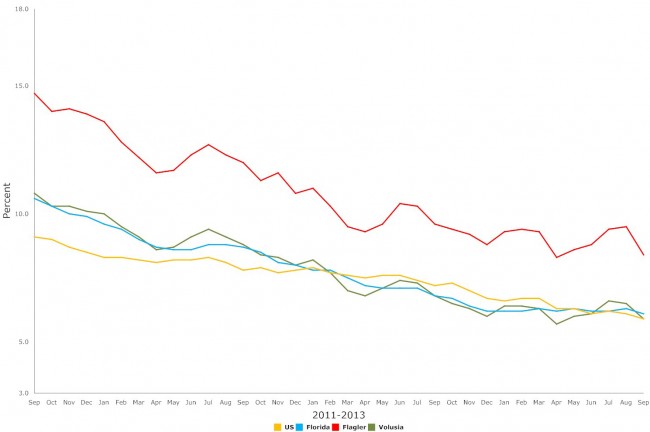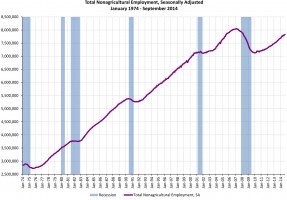
Flagler County still has the second-highest unemployment rate in the state, but September was a banner month for the county’s economic health in almost every regard.
Some 474 residents got jobs over the month, the highest single-month gain of the year, and a total that represents more than a third of the the 1,161 net new jobs for Flagler residents over the last 12 months. That doesn’t mean that so many jobs were created within Flagler County, but that county residents found those jobs in Flagler and neighboring counties. (The number reflects all jobs, including part-time work: a person logging one hour’s work over the month will not count as unemployed.)
The net new jobs benefited mostly existing county residents, not new residents: the county’s workforce grew, but only by 107, to a total of 36,112, or about 700 more than a year ago. And the county’s unemployed saw their ranks shrink to 3,048, down 387 over the month, and down 468 over the year.
The combination of lower unemployment and a steady workforce helped plummet the unemployment rate to 8.4 percent, or 1.1 percent lower than it was in August. That’s the single steepest drop in Flagler’s unemployment rate since the Great Recession began in late 2006. It is not the lowest unemployment rate since: Flagler registered an 8.3 percent unemployment rate last April, only to see the rate rise back up to 8.6 percent the following month, and 9.5 percent in August. But the trend of relatively steady improvement remains.
Flagler is still behind Hendry County’s state-leading unemployment rate of 812 percent. Flagler is tied with Hardee in second, and not far from three counties tied for fourth, at 8.1 percent–Hernando, Glades and Hamilton. St. Johns remains at the opposite end with an enviable rate of 4.8 percent. Monroe has the lowest rate, at 3.7 percent.

Today’s news is a boon to Rick Scott’s campaign, which has attempted to blame the Great Recession squarely on Charlie Crist, who was governor at the time.
“Charlie is the zero-wage governor: 832,000 people went from wages to zero wages when Charlie was governor,” Scott said during Wednesday’s televised debate. Crist’s response: “It is unbelievable that he would continue to say that, but he says it. And he also says he created all these new jobs all by himself.”
CareerSource sent the following summary for the Palm Coast metro area, which includes all of Flagler: Nonagricultural employment in the area was 20,700 in September 2014. Total nonagricultural employment was up 300 jobs over the year. Leisure and hospitality gained the most jobs over the year, adding 300 jobs, followed by trade, transportation, and utilities and professional and business services (100 jobs each). The only industry losing jobs over the year was government (200 jobs). The Palm Coast metro area had the highest annual employment growth rate in leisure and hospitality (8.8 percent) of all the metro areas in Florida in September.
![]()
Unemployment Report, September 2014





























Dlf says
Who takes stock in these numbers?
yosh says
do we know who hired all these people? are they permanent positions?
marty says
“Leisure and hospitality gained the most jobs over the year, adding 300 jobs, followed by trade, transportation, and utilities and professional and business services (100 jobs each). The only industry losing jobs over the year was government (200 jobs). The Palm Coast metro area had the highest annual employment growth rate in leisure and hospitality (8.8 percent) of all the metro areas in Florida in September.”
And we all know how well “leisure and hospitality” jobs pay – NONE of these stats is truly understandable until you examine what these jobs pay, and especially compared to the ones that people may have had previously. A person who makes $19 an hour, gets laid off and spends 6 months or so on unemployment and then “gets a job” paying $8 an hour has “found a job” – but the economic step down is massively hurtful. Multiply this by millions and it’s clear that any “recovery” needs to be seen in this larger context.
6 years after the crash – middle class income is flat, and has been for decades – the rich (and especially the smallest % of them) are now richer than ever. The supposed “recovery” has still yet to reach the overwhelming majority of Americans.